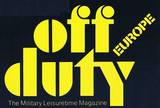"off duty" 1970 - 1997 - eine Freizeit-Zeitung für's US-Militär
Die in diesem amerikanischen (Freizeit-) Shopping-Magazin angepriesenen Hifi- und Video-Produkte waren auschließlich amerikanischen und kanadischen Militärangehörigen zugänglich - also zu kaufen - und vor allem zu ganz ungewöhnlich (verblüffend) niedrigen US $ Military-Preisen. Zu der einführenden "off duty" Seite geht es hier lang. - Um 1970 begann der weltweite Hifi-Boom bis zum 1. Crash 1978 und dann wieder zum 2.Crash um 1990. Über die 20 Jahre nach 2001 lesen Sie mehr in den Kolumnen auf diesen japanischen Seiten.
.
Wie funktioniert das Magnetband und welche gibt es
Interessant ist am Ende der Seite die Auflistung der im Military Markt angebotenen Bänder und Kassetten. Es gibt natürlich noch viel viel mehr, doch nicht alle Hersteller wollten in diesem Preiskrieg mitmachen.
.
The Magic Ribbon
Magnetic recording tape has come a long way in the past few years - here's what's available to the military audiophile - Off Duty / Europe / July 1973 By THOM PRINGLE
.
Als die Magnetophone nach USA kamen ....
EVER SINCE JOHN MULLIN took two liberated (befreite ???) German Magnetophons back (zurück ???) to the U.S. after World War II and gained backing from a very impressed Bing Crosby, the magnetic tape recording field has boomed (and earned Crosby a fortune in the process). Of course, tremendous technical changes have been made in the meantime, and one of the things which has received a great deal of attention is the magnetic recording tape itself.
.
- Anmerkung : Das ist der typische immer wiederholte Ampex Werbetext, "sie" bei Ampex hätten die Idee von Jack Mullin bekommen. Doch das stimmt nicht so ganz. Das deutsche "Magnetophon K4" sogar mit HF-Vormagnetisierung wurde bereits im Spätherbst 1945 !!!! im Wirtschaftsministerium in Washington DC einem ausgewählten Kreis eingeladener Firmenchefs und Redakteuren vorgeführt. Der Bericht darüber steht hier im Tonbandmuseum.
.
Das Geheimnis - die Erzeugung von Magentfeldern
The whole idea of magnetic recording is to create magnetic fields in a stable substance on a linear time basis which can later be detected and translated to electrical signals again.
During the search for a type and form of substance to serve as a base, a variety of things were used including steel bands, yarn dusted with metal powder, wire and several forms of what we now call "tape".
Today's magnetic recording tapes are the culmination of decades of research and are tremendously sophisticated in comparison with former products. And, with the current research being conducted, you can look forward to even better tapes in the future.
Es ist schwer, die "Tapes" auseinander zu halten
For the audiophile, it is difficult to differentiate on a quality basis between the many tapes on the market today. With the increased competition among manufacturers (it's a lucrative business), new developments and improvements seem to be incorporated in almost all tapes within a matter of days. There are some differences between types of tape, however, and you should know about these so you can go type shopping even if you can't go brand shopping.
.
Backing materials.
Almost all manufacturers use either polyester or mylar (der 3M geschütze Name für das deutsche PVC) plastic bases for their tapes today. It has more tensile strength, handles better and lasts longer. You have very little choice here.
.
Oxides.
The metallic coatings which are added to the backing material are the key to recording quality, and manufacturers are extremely careful with these compounds. Basically, you'll be faced with only three types, each of which has characteristics you should know about.
.
Regular ferric oxide.
The definition of "regular" has changed several times over the last few years and now many manufacturers consider "low-noise" tapes to be standard or regular tapes. In any case, regular oxide tapes can be used with most machines and do not require special alterations for satisfactory performance. Often, improved regular oxides such as some of the low-noise types have been improved through refinement of the coating techniques (such as oxide particle orientation) rather than changing the oxide formula.
.
Special high-performance ferric oxides.
Through new oxide development and treatment, manufacturers have come up with a series of ferric oxides which have better magnetic properties than their regular cousins. These oxides can either be driven harder, are easier to magnetize, have better frequency response characteristics or something which makes their performance outstanding.
Many of these oxides require special changes in the recording equipment to take full advantage of their properties. Therefore, while you can get improved performance from these oxides, you should be aware that this may depend on whether the tape you select will work properly in your recorder.
.
Chromium Dioxide.
This is a special oxide with extended high-frequency response and increased saturation limits. It is now available only in cassette format since it contributes the most to cassette operations where high-frequency reproduction is always a problem.
When this oxide first appeared, it was hailed as the answer to seemingly all recording problems but now the special ferric oxides give performance almost as good, without the serious drawbacks connected with chromium dioxide. (Biggest disadvantages are that it's rough on recording heads and always requires specially adapted recording circuitry.)
.
Thickness.
Once you've selected the type oxide you want, you'll have to decide what tape thickness you want. Of course, the thinner the tape, the longer you can record with one reel or cassette.
The problem is that thin tapes can be, and usually are, hard to handle since they twist, turn and buckle with the greatest of ease.
In open-reel tapes, normal thickness is 1.5 mils and the thinnest generally available tape is o.5 mil. In cassettes (which are rated in minutes rather than in feet or thickness) a 60-min. cassette contains tape about 0.75 mil thick while the longer 120-min. cassette contains ultra-thin tape about 0.3 mil thick. To determine playing times check a footage-time chart such as the one in this article.
.
RECORDING ONE DIRECTION
Footage-Time Chart
| LENGTH | 1 7/8 I.P.S. | 3 3/4 I.P.S. | 7 1/2 I.P.S. |
| 150 Ft. | 15 min. | 7 1/2 min. | 33A min. |
| 225 Ft. | 24 min. | 12 min. | 6 mm. |
| 300 Ft. | 30 min. | 15 min. | 71/2 min. |
| 600 Ft. | 1 hr. | 30 min. | 15 min. |
| 900 Ft. | 1 1/2 hrs. | 45 min. | 22 1/2 min. |
| 1200 Ft. | 2 hrs. | 1 hr. | 30 min. |
| 1800 Ft. | 3 hrs. | 1 1/2 hrs. | 45 min. |
| 2400 Ft. | 4 hrs. | 2 hrs. | 1 hr. |
| 3600 Ft. | 6 hrs. | 3 hrs. | 1 1/2 hrs. |
.
Die Hersteller von "OPEN-REEL" Bändern im Military Sales 1973
Hier ist nicht ersichtlich, ob das nur bezahte Einträge sind wie bei den Gerätefirmen auf den off-duty surveys - den Marktübersichten.
.
REGULAR FERRIC OXIDE
.
- Agfa
PE 31 - (3-in. to 10 1/2". reels, 210-4200 ft.) 1.5 mil, polyester. Audio clubs.
PE 41 - (3-in. to 8 374" reels, 300-3280 ft.) 1.0 mil, polyester. Audio clubs. - BASF
LP 35 - (7-in. reel, 1800 ft.) 1.4 mil, polyester. Available in library box. Audio clubs. - Capitol 2 (ehemals Audio Devices)
All-purpose - (3-in. reel, 300 ft.) 0.5 mil, polyester. In mailing box. EES.
All-purpose - (5-in. and 7-in. reels -900, 1800 ft.) 1.0 mil, polyester. EES.
Long-play - (7-in. reel, 2400 ft.) 0.5 mil, polyester. EES.
Low-Noise - (7-in. reel, 1200 & 1 800 ft.) 1.5 mil and 1.0 mil, polyester. EES. - Irish
231 - (5-in., 7-in. reels - 600, 1200 ft.) 1.5 mil, mylar. Direct mail order.
241 - (5-in., 7-in reels - 900, 1800 ft.) 1.0 mil, mylar. Direct mail order.
251 - (7-in. reel, 2400 ft.) 0.5 mil, mylar. Direct mail order.
261 - (7-in. reel, 3600 ft.) 0.5 mil, mylar. Direct mail order. - Scotch
203 - (7-in., 10/2-in. reels - 1800, 3600 ft.) 1 mil, polyester. Audio clubs.
212 - (7-in. reel, 1 800 ft.) 1.0 mil, polyester. Plastic library box. EES.
215 - (7-in. reel, 1800 ft.) 1.0 mil, polyester. Plastic library box. Audio clubs.
223 LP - (7-in. reel, 1800 ft.) 1.0 mil, polyester. Plastic library box. Audio clubs.
224 DP - (7-in. reel, 2400 ft.) 0.5 mil, polyester. Plastic library box. Audio Clubs. - TDK
150-7 - (7-in. reel, 1800 ft.) 1.5 mil, polyester. Audio clubs.
.
Special High-Perf ormance Ferric Oxides
.
- Agfa
PE 36 High-output/Low-noise - (3-in to 10 1/2" reels - 210 to 4200 ft.) 1.5 mil, polyester. Plastic library box. Audio clubs.
PE 46 High-output/Low-noise - (3-in. to 8 374" reels - 300 to 3280 ft.) 1.0 mil, polyester. Plastic library box. Audio clubs.
PE 66 High-output/Low noise - (3-in. to 7-in. reels - 450 to 3600 ft.) 0.5 mil, polyester. Plastic library box. Audio clubs. - BASF LP 35 LH High-output/Low-noise
(7-in., 10/2-in. reels - 1800, 3600 ft.) 1.4 mil, polyester. Available in library box. Audio clubs. - Irish
274 High-output/Low-noise - (7-in. reel - 1800 ft.) 1 mil, polyester. Direct mail order.
276 High-output/Low-noise - (7-in. reel, - 1200 ft.) 1.5 mil, polyester. Direct mail order. - Maxell
UD 35-7 (UD-35-10) High-output/ Low-noise - (7-in., 10/4-in. reel - 1800,3600 ft.) 1.0 mil, polyester. Audio clubs. - Memorex
1.5-mil High-output/Low-noise - (7-in„ 10 1/2-in. reel - 1200, 2500 ft.) 1.5 mil, polyester. Audio clubs.
1.0-mil High-output/Low-noise - (7-in., I0 1/2-in. reel - 1800, 3600 ft.) 1.0 mil, polyester. Audio Clubs.
0.5-mil High-output/Low-noise - (7-in. reel - 2400 ft.) 0.5 mil, polyester. Audio clubs. - Scotch
206 High-output/Low-noise - (10/2-in. reel - 2500 ft.) 1.5 mil, polyester. Audio clubs.
207 High-output/Low-noise - (7-in., IO/2-in. reel - 1800, 3600 ft.) 1.0 mil, polyester. Audio clubs. - Sony
SLH-7-550 BL High-output/Low-noise - (7-in. reel - 1800 ft.) 1.0 mil, polyester. Audio clubs.
SLH-11-740 B High-output/Low-noise -(10 1/2" reel -2400 ft.) 1.5 mil, polyester. Audio clubs. - TDK
1800 SD High-output/Low-noise - (7-in. reel - 1800 ft.) 1.5 mil, polyester. Audio clubs.
3600 SD High-output/Low-noise - (10 1/2-in. reel - 3600 ft.) 1.5 mil, polyester. Audio clubs.
.
8-TRACK CARTRIDGES
.
- Ampex
381 - (40, 80min.) EES. - Irish
8-Track Cartridge - (32, 40, 64, 90 Min.) Direct mail order. - Memorex
703 - (45, 60, 90 min.) Audio Clubs. - Scotch
S-8TR-90 -(90 min.) Audio clubs.
.
CASSETTES
.
- Regular Ferric Oxide
- Agfa
Standard Cassette - (60, 90, 120 min.) Audio clubs. - Ampex
360 - (40, 60, 90, 120 min.) Special order. - BASF
SK - (60,90min.)Audioclubs. - Capitol (Audio Devices)
Mod Line - (40, 60, 90, 120 min.) EES. - Irish
199 - (30, 60 min.) Direct Mail Order. 261 - (30, 60, 90, 120 min.) Direct Mail Order. - Scotch
Dynarange - (60, 90, 120 min.) Audio clubs and EES. - Sony
Standard Series - (60, 90 min.) Audio Clubs. - TDK
Standard Series - (60, 90, 120 min.) Audio clubs. - Special High-Performance Ferric Oxides
- Ampex
364 - (40, 60, 90 min.) Special order. - BASF
LH - (60, 90, 120 min.) Audio clubs. - Capitol (Audio Devices)
Capitol-2 - (40, 60, 90, 1 20 min.) Special order. - Irish
262 - (60, 90 min.) Direct mail order. - Maxell
UD - (60, 90, 120 min.) Audio clubs. - Memorex
Memorex 2 - (45, 60, 90, 120 min.) Audio Clubs. - Scotch
High-Energy - (60, 90 min.) Audio clubs. - Sony
HF - (90, 120min.)Audioclubs. - TDK
Super Dynamic (SD) - (30, 60, 90, 120 min.) Audio clubs. - Chromium Dioxide
- Agfa
Stereochrom - (60, 90 min.) Audio clubs. - Ampex
363 - (40, 60, 90 min.) Special order. - BASF
Chromdioxide - (60, 90, 120 min.) Audio clubs. - Memorex
Memorex - (45 min) Audio clubs. (60, 90 min.) EES. - TDK
Crom-02 - (60, 90 min.) Audio clubs.
.


